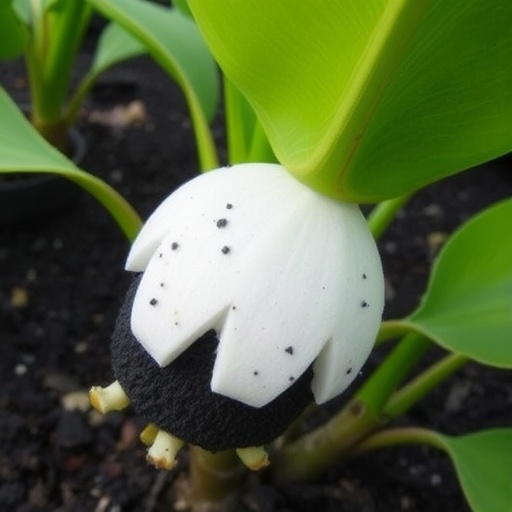In a groundbreaking study that seeks to address the pervasive challenge of water pollution, researchers have turned their attention to the effectiveness of activated carbon derived from banana stems in mitigating atrazine, a widely used herbicide. Atrazine is notorious for its environmental persistence and potential health risks, making its removal from water sources not only a scientific endeavor but also a societal necessity. The study, published in the journal Environmental Science and Pollution Research, sheds light on an innovative approach that harnesses agricultural waste to combat water contamination.
Activated carbon is widely recognized for its adsorption properties, making it an essential material in water treatment processes. However, the environmental cost associated with traditional activated carbon production, largely derived from fossil fuels, has necessitated the exploration of sustainable alternatives. This research utilizes banana stems—an abundant agricultural byproduct—as a precursor for activated carbon. By converting banana stems into an adsorbent material, the study presents a dual solution: reducing agricultural waste while creating a viable tool for environmental remediation.
The methodology employed in this research involves a series of carefully designed experiments to evaluate the efficiency of banana stem-derived activated carbon in removing atrazine from aqueous solutions. During the batch studies, varying concentrations of atrazine were treated with the activated carbon, allowing researchers to quantify the adsorption capacity and determine optimal conditions—including contact time, temperature, and pH levels—that maximize the herbicide’s removal rate. The findings from these batch experiments highlight the material’s remarkable efficiency, further emphasizing its potential as a cost-effective solution for water treatment.
In addition to batch studies, the researchers conducted column experiments that simulate real-world applications of water filtration. These experiments provided insights into the dynamic flow of water through packed columns of activated carbon, thus elucidating factors that could influence performance in actual treatment scenarios. The results were promising, indicating that banana stem-derived activated carbon maintains consistent removal efficiencies over extended periods of operation. This stability is crucial for developing sustainable water treatment systems that can be deployed in various environmental contexts.
Moreover, the regeneration studies carried out by the researchers play a vital role in determining the long-term viability of using activated carbon in water treatment. By assessing the effectiveness of reactivating spent activated carbon, the study confirms that banana stem-derived material can be regenerated multiple times without significant loss of adsorption capacity. This characteristic not only enhances the economic feasibility of the treatment method but also aligns with sustainable practices aimed at minimizing waste and resource consumption.
The implications of this study extend beyond the realm of environmental science; they touch upon broader themes of sustainability and resource management. The exploration of banana stem-derived activated carbon highlights the importance of circular economy principles, where waste materials are repurposed for valuable applications. This approach not only mitigates environmental pollution but also provides farmers with a potential income stream from waste that would otherwise contribute to environmental degradation.
As concerns about water quality and pesticide runoff continue to rise, innovative solutions such as this one are more crucial than ever. The adoption of sustainable practices and technologies is essential for addressing the mounting challenges posed by pesticide contamination, particularly in agricultural regions. The findings from this research contribute valuable insights to the ongoing discourse surrounding sustainable agriculture and the need for integrated water management strategies.
Furthermore, the study underscores the importance of interdisciplinary collaboration in tackling environmental challenges. By leveraging expertise from agricultural sciences, environmental engineering, and toxicology, the research team has created a holistic approach that not only considers the effectiveness of the adsorbent material but also its environmental impact and socio-economic implications. This collaborative framework is essential for fostering innovation and developing comprehensive solutions that can be implemented in real-world scenarios.
The urgency of addressing water contamination cannot be overstated. As global populations increase and agricultural practices intensify, the potential for pesticide leaching into water supplies grows. Therefore, the research presented in this study serves as a crucial step toward safeguarding public health and environmental integrity. By focusing on both the technical aspects of atrazine mitigation and the broader implications of utilizing agricultural waste, the study represents a significant contribution to the field of environmental science and pollution research.
The use of banana stems for activated carbon production also raises interesting questions about agricultural practices and food systems. It invites a reevaluation of how byproducts from farming can be transformed into valuable resources for addressing pressing environmental issues. Such innovations could redefine the relationship between agriculture and environmental stewardship, paving the way for more sustainable practices that benefit both farmers and communities.
In conclusion, the study on the mitigation of atrazine pesticide from aqueous media using banana stem-derived activated carbon reveals promising avenues for tackling pesticide pollution in water systems. The findings not only showcase the material’s effectiveness but also align with the growing necessity for sustainable and economically viable water treatment solutions. As the world faces unprecedented environmental challenges, research like this highlights the potential for innovative approaches rooted in sustainability and resourcefulness. The journey toward cleaner water continues, and this study adds a vital chapter to the ongoing narrative of environmental protection and agricultural innovation.
Subject of Research: Mitigation of atrazine pesticide from aqueous media using banana stem-derived activated carbon.
Article Title: Mitigation of atrazine pesticide from aqueous media using banana stem-derived activated carbon: batch, column, and regeneration studies.
Article References:
Amidu, H., Kiti, J., Annan, E. et al. Mitigation of atrazine pesticide from aqueous media using banana stem-derived activated carbon: batch, column, and regeneration studies.
Environ Sci Pollut Res (2025). https://doi.org/10.1007/s11356-025-37104-w
Image Credits: AI Generated
DOI: https://doi.org/10.1007/s11356-025-37104-w
Keywords: Atrazine, Activated Carbon, Banana Stem, Water Treatment, Environmental Science, Pollution Research, Sustainability, Regeneration Studies.




